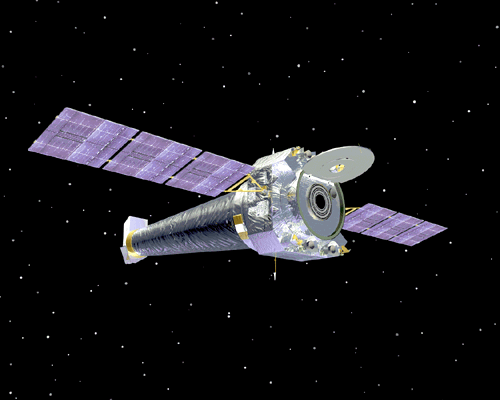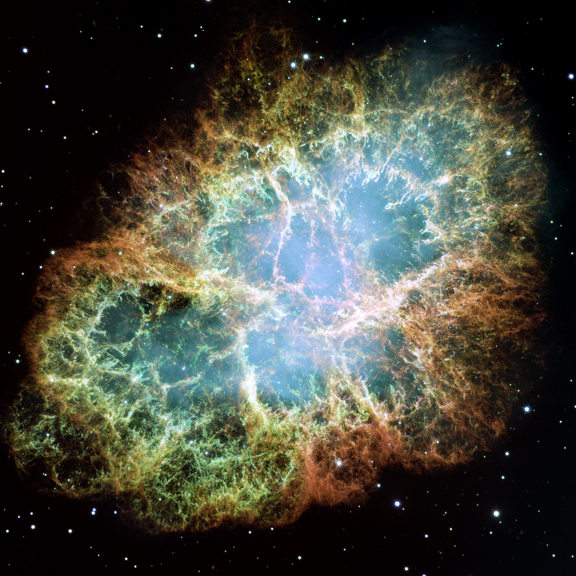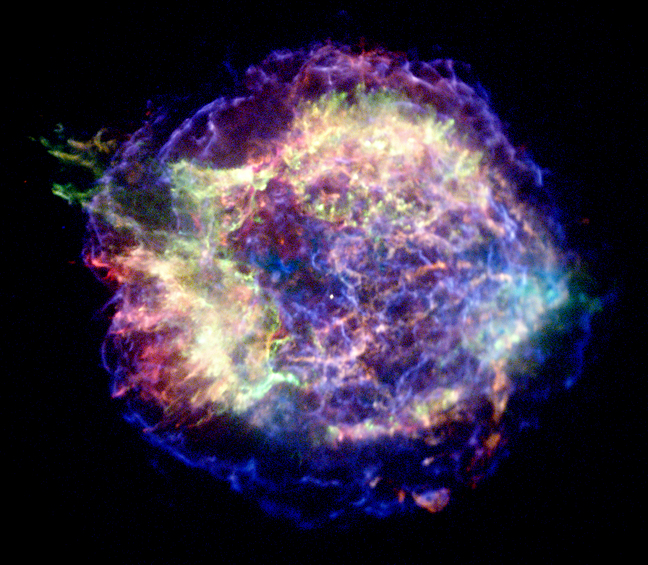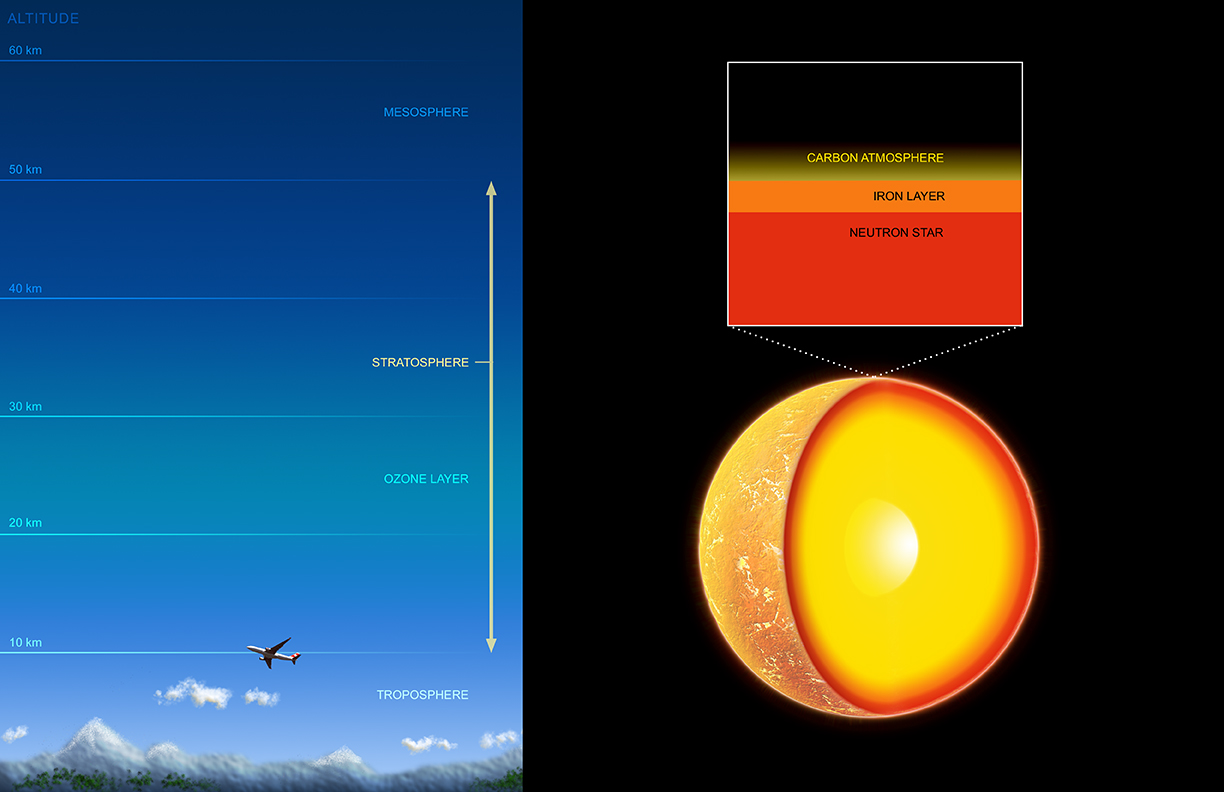
This page gives some information on our discovery of a carbon atmosphere on a neutron star, in the supernova remnant Cassiopeia A (Ho and Heinke 2009, Nature). Press releases, links to published stories, and an independent opinion are at the bottom. Please email me (heinke (at) ualberta [dot] ca), or my collaborator Wynn Ho of Southampton Univ., UK (wynnho (at) slac [dot] stanford [dot] edu) with additional questions.

The Chandra X-ray Observatory (NASA).
We used the Chandra X-ray Observatory to study X-rays coming from the neutron star. X-rays are electromagnetic radiation, just like visible light, except that X-rays are higher energy (and thus shorter wavelength). X-rays are blocked by the Earth's atmosphere, so to observe them we use satellites like NASA's Chandra telescope. Neutron stars are tiny, incredibly dense remnants of dead stars, compressing as much mass as our Sun into a star the size of a city.
Astronomers have observed the remains of numerous supernovae, or exploding stars, using optical telescopes, as well as X-ray and radio telescopes. Supernovae are the deaths of massive stars, more than 8 times more massive than our sun. During the supernova, the core (about 1.4 times the mass of our sun) collapses into a tiny stellar remanant, while the rest of the star is blown out into space. The explosion is as bright as an entire galaxy, 100 billion stars. Supernova explosions produce most of the elements we see in the universe (e.g. iron, gold, sodium, aluminum, uranium); without supernovae spreading these elements throughout the galaxy for later generations of forming stars, it would be difficult to produce planets like Earth or have life.


Left: Crab Nebula supernova remnant, optical (HST, NASA/ESA). Right: supernova remnant G292.0+1.8, X-ray (Chandra, NASA).
Above are images of the famous Crab Nebula supernova remnant in visible light (taken with the Hubble Space Telescope) and the supernova remnant G292.0+1.8 in X-rays (with Chandra). Both contain radio pulsars, rapidly spinning neutron stars with powerful magnetic fields. Charged particles, accelerated by those fields, produce radio emission near the pulsar's magnetic poles, and synchrotron nebulae that are sometimes visible in the X-ray and optical. These bluish nebulae are visible in both the images above (just to the lower left of center in the G292.0+1.8 image, and filling the interior of the Crab).

Deep Chandra X-ray image of the young Cassiopeia A supernova remnant. Credit: NASA/CXC/MIT/UMass Amherst/M.D.Stage et al.
The Cassiopeia A (or Cas A) supernova remnant is particularly young, nearby, and bright. Astronomers had long suspected it might contain a neutron star. Chandra revealed a mysterious point source inside the remnant (seen at the center of the above deep image, and below). Its brightness doesn't vary with time, indicating that the object is not a black hole (X-ray emission from black holes doesn't come from the black hole itself, but from matter being torn apart as it plunges into the black hole, and thus is naturally highly variable), so the logical conclusion was that this object is a neutron star.

A Chandra X-ray Observatory image of the supernova remnant Cassiopeia A, with an artist's impression of the neutron star at the center of the remnant. The discovery of a carbon atmosphere on this neutron star resolves a ten-year old mystery surrounding this object. Credit: Chandra image: NASA/CXC/Southampton/W.Ho; illustration: NASA/CXC/M.Weiss
However, this object didn't behave as expected. It does not emit radio pulsations, or show other evidence of being a radio pulsar. If it's a neutron star, it must have a relatively weak magnetic field, compared to many others.
Even more puzzling was its energy spectrum (how bright it is in different wavelengths). Its spectrum appears to be that of a hot (million degree), dense object. But if you know the distance, brightness, and temperature of such an object, you can estimate its size. The size that astronomers first estimated for this object was only ~0.2 km, much less than the predicted diameter of ~23 km for neutron stars.
However, the radiation from a neutron star is modified by its passage
through the star's atmosphere. Neutron stars consist mostly of
neutrons, due to the intense gravity and pressure that compresses
matter to this dense state. But the very outer layers of a neutron
star are composed of normal matter, with a solid crust and a hot but
very thin (only 10 cm thick) atmosphere. This atmosphere is stratified by the
intense pull of gravity, with the heaviest elements at the bottom and
lightest on top. Hydrogen is the lightest element, so astronomers expect
hydrogen to be at the top of neutron star atmospheres, if it exists.

An artist's impression of the neutron star in Cas A showing the tiny extent of the carbon atmosphere. The Earth's atmosphere is shown at the same scale as the neutron star. Credit: NASA/CXC/M.Weiss
All previous neutron stars that astronomers have studied can be explained with an atmosphere made of hydrogen. So astronomers (e.g. George Pavlov of Penn State University) had taken models of hydrogen atmospheres and compared them to the radiation from the Cas A object. The size they inferred was still too small; ~9 km across, vs. ~23 for a neutron star.
The obvious solution was if only a small part of the neutron star was radiating. But if so, we'd expect the neutron star, as it rotated, to bring that part into and out of our line of sight, thus changing the brightness of the star. No such changes (or pulsations) have been seen, which makes this solution somewhat difficult.
Another solution would be if the star was actually this small. Neutron stars can't be this small, but stranger stars that could be this small have been theorized and might exist. These hypothetical objects are called "strange stars"; their existence hinges upon a theorized alternate state of matter, called "quark soup", which would free the quarks that exist inside protons and neutrons into a sea of free quarks. If such objects exist and are stable, they could be the right size, because a quark star might be bound not by gravity, but by the forces between quarks. No clear evidence exists for "strange stars", so astronomers were reluctant to infer their existence while alternate explanations remained.
Our identification of a carbon atmosphere for the Cas A object provides this alternate explanation. We fit the X-ray data for the Cas A object with a variety of atmosphere models, finding that only a carbon atmosphere can explain the X-ray data while allowing a neutron star-sized object (between 17 and 30 km across). This explains the Cas A object as a normal neutron star, but with a twist of a carbon atmosphere.
Why should the Cas A neutron star have an atmosphere of carbon, when other neutron stars have hydrogen atmospheres? We hypothesize that the youth of this neutron star holds the explanation. Neutron stars cool down after their births, from temperatures of billions of degrees at their formation. At temperatures well over a million degrees, the hydrogen and helium on the surface of the star can undergo nuclear fusion to produce carbon.
But why would older neutron stars have hydrogen atmospheres? Neutron stars will collect a gentle, light rain of gas (including hydrogen) from their supernova remnants, which will eventually build up a hydrogen atmosphere if it's not being burned away. So we think that older neutron stars have cooled enough to accumulate a hydrogen atmosphere.
This discovery solves a ten-year mystery as to the nature of this object, and identifies the first carbon atmosphere on a neutron star (the first neutron star atmosphere not composed of hydrogen). It is important for understanding how neutron stars change over time, and the details of supernova explosions.
Links to releases and stories will be added below when available.
Press releases: Chandra X-ray Center, U. of Alberta, U. of Southampton, U of A RSO, NASA Marshall Space Flight Center, NASA multimedia
Radio broadcasts: Nature podcast, CBC's Quirks & Quarks.
Stories:
Nature
Physics World
Universe Today
Space.com
Edmonton
Journal
Edmonton Sun
Canadian
Press
CBC print
Sky & Telescope
Discovery Channel
Astronomy Now Online
Redorbit.com
Wired
Canada.com
Global
TV Calgary
Space Fellowship
Dueling Space Daily versions:
Edmonton
version;
Boston
version.
Astronomy
magazine
Daily
Telegraph (UK)
PhysOrg.com
Absolute Radio UK
Vancouver
Sun
Yahoo
News
MSNBC
ScienceBlog.com
Innovations Report
Ars Technica
Steinn Sigurdsson's blog "Dynamics of Cats"
An independent comment by Prof. Lars Bildsten, a world expert in the
interpretation of neutron stars:
---------------------------------------------------------------------------
Ever since the discovery by Chandra of a bright point source in the center
of this famous supernova remnant, we have been puzzled to explain it. We
expect a young neutron star, but modeling the emission ran into serious
problems; either the radius was far too small, or the data demanded that
pulses due to rotation should be seen, but they never were. The combined
theoretical and observational work of Ho and Heinke has solved this
problem, and revealed some astonishing new properties of neutron stars.
Their realization that this young neutron star has a surface made of hot carbon as dense as diamonds allows for an explanation of the data with the expected 10 km neutron star radius. Understanding these dense and high pressure (more than ten times that at the center of the Earth!) carbon atmospheres required considerable theoretical effort, which when combined with the data from the Chandra observatory, finally revealed a diversity of outcomes more consistent with the huge diversity of outcomes we witness in the supernovae that create neutron stars.
We knew for many years that white dwarfs (the much less dense stellar remnants made from less massive stars) had a variety of surface coverings, from hydrogen to helium, but the Sloan Digitial Sky Survey has recently also found that some white dwarfs have nearly pure carbon atmospheres. Given that the cores of white dwarfs are typcially made of carbon and oxygen, this may not be too surprising, but it does say we have reached the limit of what's likely. However, neutron stars are born in much more dramatic core collapse events, suffer tremendous bombardment of their surface layers, and can be hot enough to fuse light elements. It's likely that these discoveries are just beginning....
Lars Bildsten
Permanent Member, Kavli Institute for Theoretical Physics
Professor of Physics, UC-Santa Barbara
=====================================================
Mailing Address: KITP, Kohn Hall, UCSB, Santa Barbara CA 93106
Phone 805 893 3979 Fax: 805 893 2431